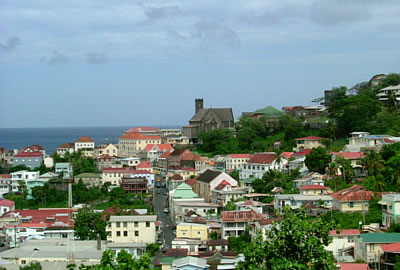Snapshots
of the Caribbean
Part 2:
Breadfruit and Mangoes
Saturday morning sees us up bright and early. We have arranged
an island tour, and our guide, Campbell, is meeting us at
9am. In the Caribbean, most times are flexible, and we are
surprised when Campbell arrives exactly on time. He outlines
the route we are about to take, and we settle ourselves
into the air-conditioned comfort of the van.
Our
first destination is St George's, the capital of the island.
The island changed hands between Britain and France for
several centuries, and although France eventually conceded
the island to Britain, there are noticeably French influences
across the island. St George's has a feel of a Mediterranean
fishing town, situated around a natural harbour full of
small boats, and presided over by an old fort. It is pretty
but run-down, with rusting tin roofs on top of houses painted
in pastel colours.
Leaving
St George's behind, we drive inland towards the
Concord waterfalls. Campbell proves to be a personable and
knowledgeable guide, always ready to impart facts about
the history and nature of Grenada. At frequent intervals,
he slams on the brakes to point out a tree or flower. He
is surprised that British girls can recognise breadfruit
and mangoes, as we have not yet told him that we live in
the Caribbean… and of course, most of the fruits he
points out can be found in the average British supermarket,
too. However, we have never seen cocoa trees, and, although
we are familiar with the banana plant, Campbell tells us
some facts we did not already know, such as the banana plant
is actually a species of grass.
Grenada
is often called the Spice Island, as it grows and exports
many spices, most notably nutmeg, of which it is the second
largest exporter in the world. Nutmeg trees grow all over
the island, and Campbell stops the van to pick a fruit for
us. The fruit is about the size of an apricot, and yellow
in colour. Inside the fruit, the brown seed sits covered
by the red mace. The whole of the nutmeg can be sold and
used - the fruit goes to make jellies and jams, the mace
is used for red colouring in the cosmetic industry, and
the seed is dried and used in cooking. Nutmeg is so important
in Grenada that the colours of the plant - red for the mace,
green for the leaves and gold for the fruit- are the national
colours of the country.
Campbell
takes us to an old plantation where nutmeg is bought from
local farmers and dried, ready to be sold. A lady there
shows us all the different spices that are produced on the
island, and we look at the baskets of nutmeg and mace. We
climb a ladder into the attic, which is full of drying nutmeg,
and also a few bats that give us a fright!
For
pictures of the nutmeg, visit the photo
page
Part
3: Round
the Island
